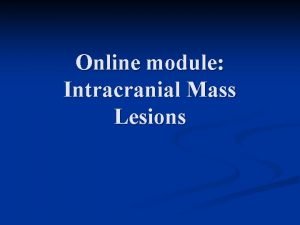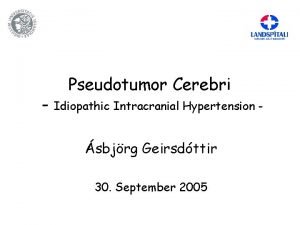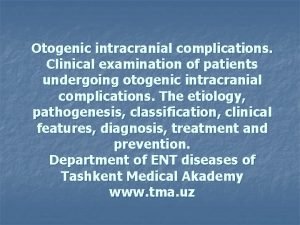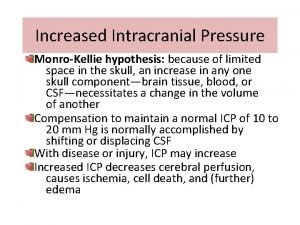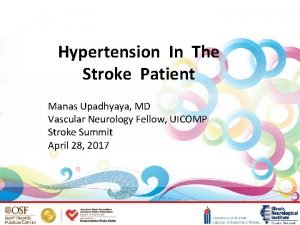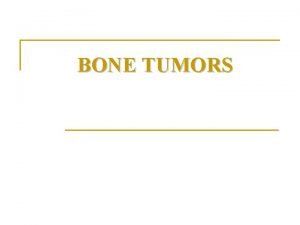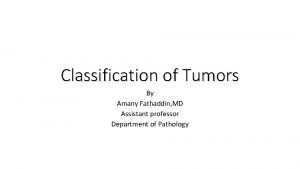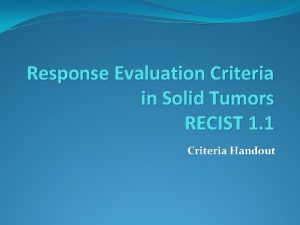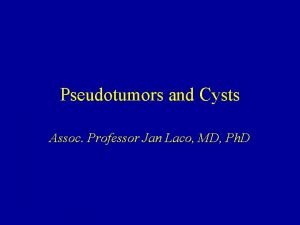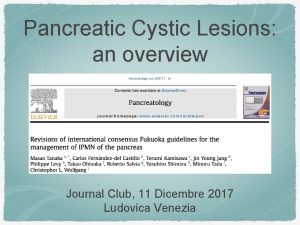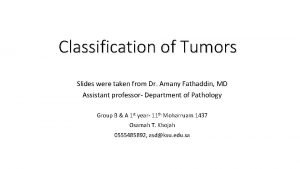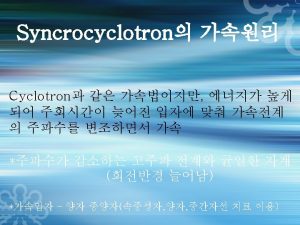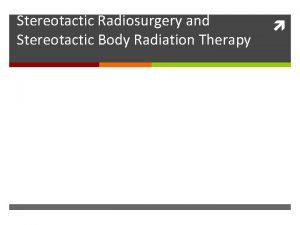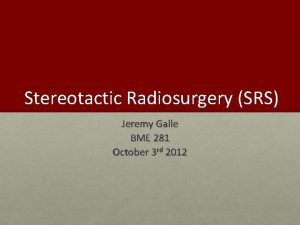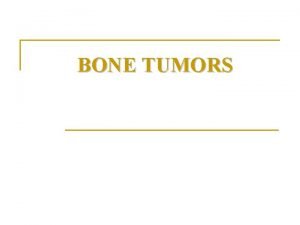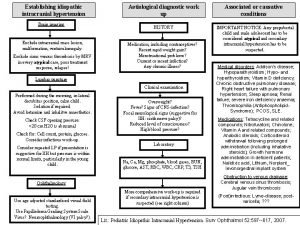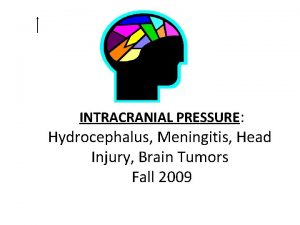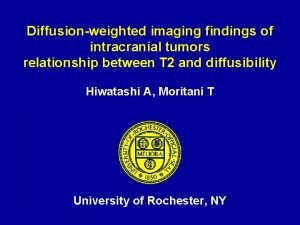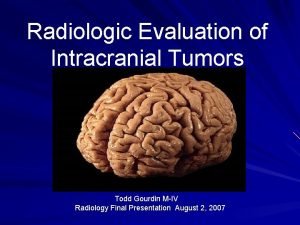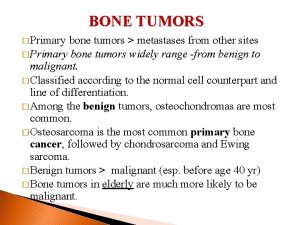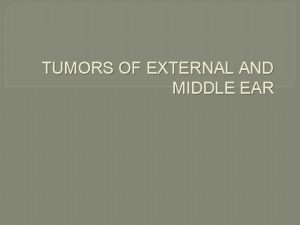STEREOTACTIC RADIOSURGERY TREATMENT OF INTRACRANIAL TUMORS 1 st

































- Slides: 33

STEREOTACTIC RADIOSURGERY TREATMENT OF INTRACRANIAL TUMORS 1 st Pyongyang International Neurosurgery Symposium, DPRK 21 -22 October, 2015 Marco Lee MD Ph. D FRCS Associate Professor Dept. of Neurosurgery Stanford University California, USA

History of SRS (very briefly, on one slide!) Harvey Cushing Radium Needles 1920 Lars Leksell Gamma. Knife Frame-based SRS  1967 Victor Horsley-Clark Apparatus 1908 John Adler Cyber. Knife Frameless SRS 1994 2015

SRS= Single session Fractionated SRS= up to 5 sessions Extra-cranial locations Spine Lung Prostate

SRS and Tumors � Benign tumors � Pituitary Adenomas (Non-functional and functional) � Vestibular Schwannomas � Meningiomas � Malignant tumors � Atypical and Anaplastic type � Metastases

59 yo Left mild hearing loss and dizziness. Growth seen over 2 years

SRS for Vestibular Schwannoma � � � Typically only if <3 cm Typically margin dose 12 -14 Gy >90% control rates at 10 years follow up 50 -70% hearing preservation >99% facial nerve preservation Growing evidence SRS has better tumor control, hearing and facial preservation than surgery in <3 cm

42 yo male. Progressive ataxia, weakness, dysphagia. Decreased but functional hearing.

Post-op grade 3 hearing loss, grade 3 facial weakness. Improved to grade 2 hearing loss and normal facial function at 3 months Diagnosis: Vestibular Schwannoma

SRS to residual tumor 6 months post-op

3 yrs post-SRS

Large (>3 cm) Vestibular Schwannomas Gross total vs. Subtotal Resection Gross Total Subtotal Resection resection (Radical (Intracapsular extracapsular) decompression ) Mean Follow up Mean tumor vol. GR Class I or II 53 months 58 months 0. 9 cc 5. 1 cc 0% 100% P<0. 001 HB Grade I or II 35% 89% P<0. 01 Pan et al, 2012

36 yo male with visual problems. Pre-op Post-op

5 years post-op MRI follow up. Patient is asymptomatic.

3 years post-SRS. Patient remains asymptomatic

SRS for Pituitary Adenomas � � � Typically margin dose 12 -20 Gy 83 -100% control rates at mean 46 mo follow up 0 -39% SRS-induced hypopituitarism (Median 8%) <7% new optic neuropathy Functional tumors require higher doses and risks of complications are higher. Maximal safe surgical resection still the goal.

45 yo facial pain and numbeness. Trial of conservative treatment and follow up MRI scan for 6 months.

CT and MRI merge

Role of the neurosurgeon, radiation oncologist and medical physicist in SRS

5 yrs post-SRS Pre-SRS Post--SRS

SRS for meningiomas • Dose varies widely depending on size and location • >80% control rates for WHO I at 10 years follow up • 10% neurological deterioration in skull base meningiomas at 10 years. • Peritumoral edema higher incidence in convexity, parasagittal and parafalcine vs. skull base meningiomas • Growing evidence for subtotal resection of large skull base meningiomas near critical neurovascular structures vs. gross total resection

Timing of SRS: Upfront vs. Waiting for recurrence Atypical and Anaplastic Meningioma

Solitary Brain Metastasis Pre SRS 2 yrs Post SRS Single Fraction

Brain metastases � � � Most common indication for SRS WBRT vs. SRS-no significant difference in overall survival, OS (1 -3 mets) WBRT + SRS longer survical vs. WBRT (6. 5 mo vs. 4. 9 mo, p=0. 039). 43% higher local recurrence and worse performance (KPS) in WBRT alone SRS vs. WBRT + SRS-no significant differecse in OS Less cognitive decline, better functional outcome and quality of life in SRS alone group. WBRT ecreased local and distant metastastases ecurrence, but not OS. SRS alone: Treatment of choice

SRS treatment to resection cavity. SRS treatment to more than 5 metastases. Resection cavity. Multiple metastases (>5) This case” 43 mets planned

Chondrosarcoma Pre-op Post-op

Spine tumor

Cerebral AVM

Spinal Cord AVM Pre SRS Post SRS

Trigeminal neuralgia

Other SRS complications � SRS induced neoplasia: Very rare (1 in 10001 in 2000 or 0. 04% risk over 15 years) � Malignant gliomas, malignant peripheral nerve sheath tumors, sarcomas and meningioma � Radiation necrosis: Is it recurrence?

Conclusions � � � Cranial, extra-cranial and non-neurosurgical sites Preferred treatment for some small tumors Subtotal resection near neurovascular critical areas with SRS used to treat residual or recurrence Preferred treatment for most metastases Evolving role in other neurosurgical conditions: Functional and Psychiatric.

Questions � � � How are you treating the vestibular schwannomas? How are you treating solitary metastases? What is your management of tumors with extension to neurovascular structures, eg. Cavernous sinus?

 Intracranial mass
Intracranial mass Intracranial regulation nursing
Intracranial regulation nursing Increased intracranial pressure ati
Increased intracranial pressure ati Decreased intracranial adaptive capacity nursing diagnosis
Decreased intracranial adaptive capacity nursing diagnosis Cushings triad
Cushings triad Intracranial pressure monitoring
Intracranial pressure monitoring Intracranial teratoma
Intracranial teratoma Nursing management of increased intracranial pressure
Nursing management of increased intracranial pressure Mosby
Mosby Intracranial hypertension
Intracranial hypertension Otogenic intracranial complications
Otogenic intracranial complications Fiber optic ventricular bolt catheter
Fiber optic ventricular bolt catheter Intracranial hypotension radiopedia
Intracranial hypotension radiopedia Intracranial pressure
Intracranial pressure Bone tumors
Bone tumors Radiothrapy
Radiothrapy Peter hino md
Peter hino md Classification of tumors
Classification of tumors Odontogenic tumors
Odontogenic tumors Spinal cord
Spinal cord Lipoma
Lipoma Response evaluation criteria in solid tumors (recist)
Response evaluation criteria in solid tumors (recist) Classification of testicular tumors robbins
Classification of testicular tumors robbins Classify odontogenic tumors
Classify odontogenic tumors Odontogenic tumors classification
Odontogenic tumors classification Mobile phone brain tumour
Mobile phone brain tumour Exocrine tumors of pancreas
Exocrine tumors of pancreas Bone tumors
Bone tumors Thyroid grading system
Thyroid grading system Enneking classification of benign bone tumors
Enneking classification of benign bone tumors Chest wall tumors
Chest wall tumors Ectocervix
Ectocervix Local invasion
Local invasion Blood clot cat
Blood clot cat
